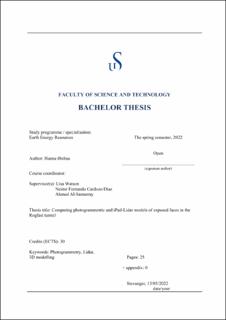| dc.description.abstract | Cameras have become progressively more advanced in the 21st century. They are a ubiquitous feature in electronic devices, which brings more opportunities for collecting data in the field and creating 3D geologic models. However, since there can be many devices to choose between, it may be difficult to know which one to select. Selecting the most appropriate device will depend on cost, ease of use, efficiency in collection and processing, and required detail of the output model.
During tunnel excavation, the rock in the exposed tunnel face is removed (front face) or covered (roof) after the section is deemed completed and reviewed by an-site geologist and deemed completed. The rocks are no longer observable and generally, there is no visual record. By using an electronic device to create a 3D geologic model during excavation, there could be a visual record of the rock exposures for future use.
This has been explored in this thesis by testing two different methods inside an excavating tunnel (part of the larger Rogfast project) in Kvitsøy, Rogaland, SW Norway. One of the methods is camera photogrammetry, which is today a standard method. Generally, it requires a high economical investment and complicated training of staff and data processing to make a virtual model. Because of these relatively high required skillsets, it would be interesting to compare this method with a new, and easier method for 3D modelling, namely the iPad Pro 2020 with a built-in terrestrial lidar scanner (TLS), which requires nearly zero training.
After a comparing the camera photogrammetry and iPad TLS in terms of ease of use, data processing, output models, efficiency, degree of difficulty, stability, and costs, it is concluded that the iPad TLS is the most efficient tool for documenting and collecting 3D geologic models during active tunnel excavation.
- It seems to me you are missing the main results here: How may faces did you look at, what did you do, what results support this conclusion? | |
